Hazardous air quality levels continued to overwhelm parts of the eastern U.S. today as a fresh wave of smoke from Canadian wildfires billowed across the border.
Major metro areas are still experiencing unhealthy air quality levels for all age groups, including New York City, Boston, Philadelphia and Washington, D.C., the National Weather Service said.
Officials have warned residents whose cities were shrouded in haze to stay indoors and wear masks outdoors.
Millions under air quality alerts
- Around 123 million people are under air quality alerts.
- New York City had the worst air quality in the world this morning, according to IQAir.com, a tracking service.
- More than 400 wildfires are burning in Canada, according to the Canadian Interagency Forest Fire Centre.
- President Joe Biden pledged to send additional firefighters to America's neighbor to the north.
- Areas from the mid-Atlantic to the Northeast should finally get a reprieve by Saturday as a wind shift pushes the smoke away.
Philadelphia schools go virtual as air quality remains poor
Image shows U.S. Capitol enveloped in smoke
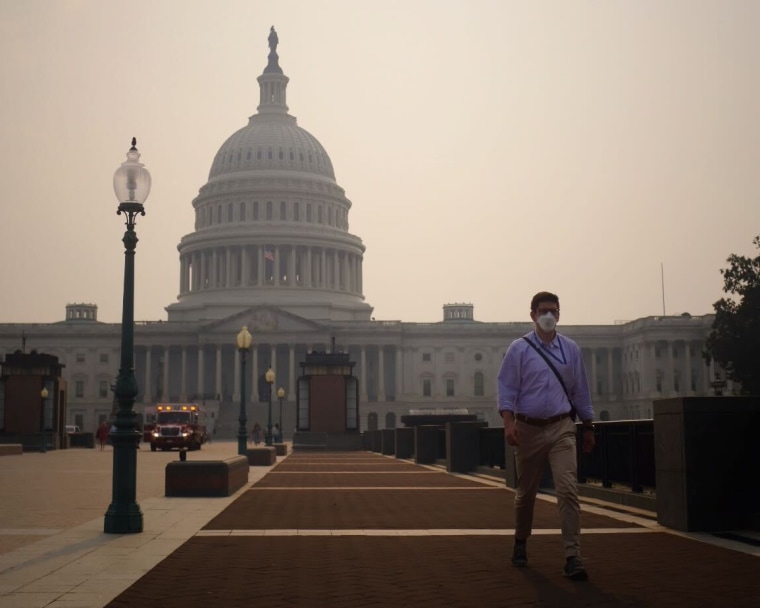
NYC delivery workers say they had ‘no choice’ but to work
On Wednesday afternoon, as New York City residents tried to make sense of the orange haze that blanketed the area, a Chinese delivery worker who services restaurants in south Brooklyn carried on despite the dangerous air conditions, dropping off orders over the course of his 10-hour shift.
“If you’re out for long periods of time, you feel your breathing become more difficult. It starts to hurt,” the delivery worker, who requested anonymity for fear of retaliation, said in Mandarin through an NBC News translation. “It’s like cigarette smoke. The more you’re out, the more your throat hurts.”
The Brooklyn-based worker, 38, is one of countless delivery people who continued to brave the conditions outside despite the city’s air quality being the worst in the world during a period of time Wednesday because of the persistent smoke caused by more than 400 wildfires in Canada. Despite advisories across all five boroughs, many delivery workers said they couldn’t afford to miss a day of work, particularly because there is no minimum wage requirement for many who operate as independent contractors.
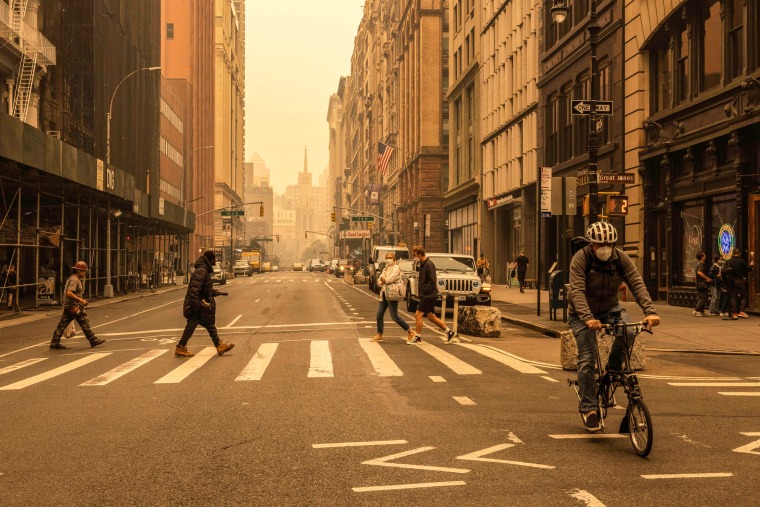
Wildfire smoke can cause some surprising symptoms
Itchy eyes, a scratchy throat and a cough probably come as no surprise when the air is thick with wildfire smoke. But poor air quality can contribute to less expected symptoms, too.
It is not uncommon for people to also experience chest pain, headaches and dizziness, according to Dr. Gregory Wu, a critical care medicine physician at Albany Medical Center in Albany, New York.
“We do encourage folks, if they’re having chest pain or chest tightness, that they should be seeking care,” Wu said. “And similarly, if folks are having headaches or dizziness, that’s another good reason to seek care, or at least get indoors.”
Persistent headaches should prompt medical attention, he added, especially if someone is not normally prone to headaches or the headache feels worse than usual.
Graphic: Canada’s wildfire season already among the largest
Canada’s wildfire season is off to a blistering start.
More than 14,000 square miles have burned through Tuesday, already making 2023 one of Canada's top five wildfire seasons since 2003, according to an NBC News analysis of Canadian Interagency Forest Fire Centre data.
This chart shows the yearly total of land burned by wildfires in Canada.
Nearly 600 flights delayed nationwide
The smoke forced airlines and airports to delay 594 flights across the country as of 4 p.m. ET, according to FlightAware, a tracking service. Six flights were canceled nationwide.
Wildfire smoke can increase risk of Covid infections
Exposure to wildfire smoke can increase a person's risk of getting Covid or developing a severe case of the disease. Smoke can irritate and inflame the lungs and weaken the immune system — factors that make people more vulnerable to lung infections, according to the Centers for Disease Control and Prevention.
A study from Harvard researchers looked at the effects of wildfire smoke on Covid cases in California, Oregon and Washington from March to December 2020. The researchers attributed more than 19,700 Covid cases and nearly 750 Covid deaths to daily increases in fine particulate matter — the term for tiny particles of pollution in the air that are less than 4% of the diameter of a human hair.
People who currently have Covid also face an increased risk of health issues from wildfire smoke such as coughing, trouble breathing or heart attack.
Air Quality Index: What's in a number?
Most air quality forecasts and alerts will include readings on what’s known as the Air Quality Index — numbers expressed on a scale from 0 to 500.
But what do these figures mean, and how should the information be used?
The Air Quality Index, or AQI, was established by the U.S. Environmental Protection Agency to measure daily air pollution and communicate the associated risks to the public. The numbers on the scale are such that higher values represent greater levels of air pollution and thus greater health risks.
AQI readings are commonly included in local weather reports, particularly when air pollution levels are elevated and advisories or alerts are active in a region. People can also check the EPA’s AirNow website for up-to-date information on local conditions and short-term forecasts.
Readings of 50 and below mean that air quality is “satisfactory,” with little to no health risks. Values between 51 to 100 represent “acceptable” air quality with moderate levels of concern. Readings between 101 to 150 are considered “unhealthy for sensitive groups,” which typically include children, older adults and people with pre-existing health conditions. When the index hits 151 to 200, air quality is considered “unhealthy” for the general public, and values from 201 to 300 mean air pollution is “very unhealthy” and there are elevated health risks for everyone. The last category, for values of 301 or higher, represents “hazardous” conditions for everyone.
In addition to the numbered values, the scale is color-coded, with green and yellow symbolizing acceptable conditions and orange, red, purple and maroon representing worsening air quality conditions.
With wildfire smoke blanketing much of the Northeast, index levels have spiked in recent days. On Wednesday, parts of New York City recorded index values over 400.
The Air Quality Index measures five major pollutants: ground-level ozone, particle pollution (which includes small particulate matter, or PM2.5, that is of particular concern with wildfire smoke), carbon monoxide, sulfur dioxide and nitrogen dioxide.
There are some limitations to the index, however. Wildfires can release other gases and hazardous air pollutants that are not measured daily by the EPA, Erica Smithwick, a landscape and ecosystem ecologist at Pennsylvania State University, said. Some of these pollutants may not be associated with immediate health impacts, but can linger in the air and carry longer-term risks, she added.
New York sending firefighters to help fight Canada blazes
New York Gov. Kathy Hochul announced Thursday that the state will send forest rangers to Canada to help them fight blazes inundating the country.
Hochul said that New York had previously offered assistance but "they are now taking us up on it."
"We’re sending our first firefighters, joining a number of individuals from New Hampshire and Maine as well. They’ll be departing from the Saratoga fire department on Friday and traveling to Quebec," she said.
So far, Canadian officials have asked for seven people over the next two weeks. Hochul said, "We can certainly change those numbers at their request."
Support from the Northeastern states will be in addition to the 600 firefighters and personnel President Joe Biden has sent to support the United States' northern neighbor.
"This is how we can deal with this," Hochul said. "Helping Canada get to these really remote areas. ... These are such remote areas they’re almost impossible to access, but containment is important to us."
Biden pledges to send more firefighters to Canada
President Joe Biden, lamenting the "devastating" wildfires in Canada and calling the blazes a "stark reminder of the impacts of climate change," promised to send additional firefighters to America's neighbor to the north.
"I have directed the National Interagency Fire Center to respond promptly to Canadian requests for additional firefighters and fire suppression assets such as air tankers," Biden said in a statement.
Biden added that Transportation Secretary Pete Buttigieg was keeping him informed about efforts to mitigate "air traffic implications." FlightAware, a tracking service, shows that more than 400 flights are delayed across the country this afternoon.
NYC tourists enjoying a respite from the acrid orange haze
Josh Stump and his family traveled to New York City from their home in West Virginia this week to take in the sights. But their vacation was upended yesterday when a sickly orange fog descended on the Big Apple.
"We were suffering pretty badly yesterday," Stump, 39, said.
Yet this morning, Stump and his wife were relieved to discover they could open the windows in their Manhattan hotel room without getting hit with the noxious smell of smoke. "The weird color is gone, the air isn't as bad, you can actually see down the block, and there are more people outside," he said.
Terry German, 48, who came up to New York City from his home in Texas, said he was glad to get a clear view of the city's famed skyscrapers as he strolled through midtown Manhattan this afternoon, suitcase in tow.
"You could barely see anything yesterday, but today things seem to be looking up," he said.
The orange haze may have dissipated, but the air quality in New York City was still poor as of 1:30 p.m. ET — approximately 160 on the air quality index scale, otherwise known as "unhealthy," according to IQAir, a Swiss monitoring service.
More than 400 flights delayed across the U.S.
The smoke forced airlines and travel hubs to delay 415 flights around the U.S. as of 1 p.m. ET, according to FlightAware, a tracking service.
Remote learning for NYC public school students on Friday
New York City public school students will have remote classes on Friday in light of unhealthy air quality conditions, the district tweeted Thursday.
Staff will have a remote workday as well.
Only some public school students were slated for in-person classes Friday as the school year wraps up.
“For schools serving grades 9-12 and 6-12 in Districts 1-32 and 79: Students and staff in these schools were scheduled to attend school in-person on June 9, we are shifting to remote instruction,” the district tweeted.
White House postpones Pride Month event because of smoke
A White House Pride event scheduled outdoors on the South Lawn has been postponed until Saturday because of the smoke, the White House announced.
Yesterday was the worst U.S. wildfire smoke day since 2006, Stanford analysis finds
The impact from the smoke bedeviling the eastern U.S. was the worst the country has seen in almost two decades, according to an analysis from a Stanford University research group.
The analysis calculated the smoke exposure experienced per person in the United States, according to Marshall Burke, an associate professor of Earth system science at Stanford University.
The research group calculated that yesterday’s smoke event was the worst since 2006. Tuesday’s smoke was the fourth-worst occurrence.
On both days, smoke exposure levels were not as high as they have reached in West Coast cities in the recent past, but the overall impact was greater because the smoke struck huge population centers like New York City.
“There’s no threshold of exposure to wildfire smoke above which we’re in trouble and below which we’re fine,” Burke said in an interview yesterday. “All evidence suggests there’s no safe level of exposure.”
He said that climate change will increase smoke risk in the eastern U.S., but that the magnitude of this event has surprised him. In the smoke, he said, he sees the fingerprints of climate change, which has raised temperatures and made fire weather more likely in North American forests.
“This event had a climate trigger for sure. There were weeks of dry hot weather, first in western Canada and then in parts of eastern Canada that precipitated the growth of these wildfires,” Burke said. “It is a wake-up call.”
Washington issues first 'code purple' day over fine air particles
For the first time, Washington has issued a "code purple" because of fine air particles, warning that air quality has reached levels that are unhealthy for everyone.
"The D.C. region has not previously recorded a Code Purple day for fine particle pollution," the Metropolitan Washington Council of Governments said on its website. "In 2012, the region recorded two days for ozone pollution that would qualify as Code Purple by the current 2015 standards."
NYC mayor says there a chance for ‘significant improvement’ tomorrow
Brighter horizons and clearer skies could be around the corner for New Yorkers, Mayor Eric Adams said in a briefing this morning.
“As of right now, the smoke models are not indicating another large plume over the city, so there’s a chance for significant improvement by tomorrow morning and throughout the day tomorrow,” he said.
As for today, he said, forecasters are expecting “gradual improvement” through the early afternoon, but a “sea breeze this afternoon could push smoke back over the city.”
“Conditions along the immediate coast, and southern boroughs will likely be worse than in the northern parts of the city. We may see continued improvements later tonight and overnight as the wind becomes light and northerly,” Adams said.
New Yorkers are under an air quality health advisory and are urged to stay indoors and wear masks outdoors.
As of 11:50 a.m., New York has the worst air quality in the world, according to the Swiss air monitoring site IQAir.
Washington Nationals game postponed
Today's MLB game between the Washington Nationals and the Arizona Diamondbacks has been called off because of poor air quality:
New Jersey governor calls poor air quality ‘unprecedented’ and ‘historic’
New Jersey Gov. Phil Murphy called the Canadian wildfire smog blanketing the Northeast an “unprecedented” event as he urged locals to stay home and avoid the outdoors.
“The widespread nature and uncommonly high levels of fine particulate concentrations reaching the unhealthy category is of a historic magnitude,” he said in a press conference this morning.
An air quality action day alert issued for todday was upgraded to the “unhealthy” category and the alert was extended to the end of tomorrow.
Murphy said the air quality index reached 226 in Jersey City at 7 a.m. and in South Jersey, it hit 285 — both within the unhealthy range.
An AQI at or below 100 is considered satisfactory, according to the Environmental Protection Agency's website AirNow.gov, but when it is above 100, air quality is considered unhealthy.
“Poor air quality impacts everyone,” Murphy said, noting exposure to high levels of particulate matter “can cause difficulty breathing, chest pains, and asthma attacks.”
What to know about masks and wildfire smoke
It's official: El Niño has begun
The National Oceanic and Atmospheric Administration confirmed today that El Niño — a naturally occurring climate cycle that influences global temperatures, rainfall patterns and severe storm systems — is back.
What does that mean for wildfires? Canada is already experiencing an intense start to its wildfire season, and El Niño conditions could make matters worse. The weather pattern is typically associated with more volatile tropical storms and hotter, drier conditions across the northern parts of the United States and Canada.
Canadian officials have said that hot and dry conditions will likely persist into the summer months, increasing the risk of wildfires through August.
Also of concern are the health risks when regions experience poor air quality at the same time as heat waves. Together, extreme heat and high levels of air pollution can put an extra strain on the body and can increase the risk of respiratory, cardiovascular and kidney diseases — particularly in vulnerable populations such as children, the elderly and people with pre-existing health conditions.
Schumer calls for more U.S. resources to help fight Canadian wildfires
Senate Majority Leader Chuck Schumer, D-N.Y., has sent a letter to Agriculture Secretary Tom Vilsack asking him to direct resources to fighting the wildfires in Canada that have produced the heavy smoke affecting air quality on the East Coast of the United States.
“The best way to ensure the U.S. does not suffer another wave of wildfire air pollution is to contain these fires up in Canada as soon as possible,” he said on the Senate floor this morning, “That’s getting at the source, and that’s what we need to do.”
Schumer also said the letter calls on Vilsack to “double the number of personnel to mitigate the risk in the air for millions of Americans.”
“To walk through New York City yesterday was to walk on another planet,” he said, “The orange fog of wildfire smoke left our city unrecognizable.”
The Smithsonian’s National Zoo in Washington closed over air quality
The Smithsonian’s National Zoo in the nation’s capital will be closed today “due to the poor air quality,” the iconic facility said in a tweet.
The closure is for “the safety of our animals, our staff and our guests.”
It comes as a "code purple" air quality alert was issued for Washington, D.C., today, meaning the air quality is very unhealthy. Under such a warning, all people should stay indoors as much as possible and wear N95 or KN95 masks if outdoors.
New Jersey air quality upgraded to 'unhealthy'
FAA delays flights bound for Newark, grounds departures to Philadelphia
The Federal Aviation Administration said Thursday morning that it had delayed all flights bound for New Jersey’s Newark Liberty International Airport nationwide. It also grounded departures to Philadelphia International Airport due to low visibility.
Masks ... but for dogs
Some pet owners are finding creative ways to safely take their dogs for walks, like buying or making masks for their pets, as smoke from the Canadian wildfires continues to wreak havoc in states across the U.S.
Not all the dogs are into it though.
EPA's "AirNow" app hits No. 12 in Apple app store
The Environmental Protection Agency's "AIRNow" app has reached No. 12 on Apple's app store ranking for all free apps, and sits at No. 1 in weather apps.
The app provides people with a quick way to check current air quality and air quality forecasts.
New York zoos and aquarium remain closed due to air quality
The Wildlife Conservation Society announced that it would keep its four zoos and one aquarium closed following bad air quality. Bronx Zoo, Central Park Zoo, Queens Zoo, Prospect Park Zoo and the New York Aquarium are closed, with their staff monitoring the health of the animals.
Animals are showing no adverse effects or health complications amid the bad air quality.
The New York City Department of Health and Mental Hygiene also recommends limited outdoor activity.
Smoke is snarling air travel. Here's what you need to know right now.
Air travel has been upended by the smoke wafting across the United States this week. Here's where things stand right now, according to FlightAware.com, a flight tracking service:
— More than 200 flights across the continental U.S. were delayed as of 9 a.m. ET., and 10 flights were canceled.
— Hartsfield–Jackson Atlanta International Airport and New Jersey's Newark Liberty International Airport are experiencing the most air travel "misery," according to FlightAware's MiseryMap.
Departures to Philadelphia International Airport grounded
A ground stop was issued for departures to Philadelphia International Airport around 8:30 a.m. this morning due to weather and low visibility, the FAA said.
The ground stop is slated to last through 9:15 a.m.
This marks the second airport this morning to experience a ground stop or delay as the East Coast grapples with another day of thick wildfire smoke.
Smoke expected to start clearing over the weekend
People across the eastern U.S. have woken up to yet another hazy day.
Conditions are expected to improve in New York City by tomorrow afternoon, however.
By Saturday, all areas from the mid-Atlantic to the Northeast should finally see a reprieve as a wind shift pushes the smoke away.
123 million under air quality alerts
An orange haze is still on the forecast today with 100 million people under air quality alerts for smoke from Canadian wildfires in 16 states and 23 million under alerts for ozone in seven states.
The wildfire smoke will continue to impact cities across the Northeast, but is anticipated to clear out by Saturday.
The air quality index level jumped above 400 for parts of New York City — in Brooklyn and Queens — for a brief time when the smog was the most dense yesterday, marking the worst air quality for the area on record.
At 4 a.m. ET today, the city’s AQI level was already at 245. As of 8:30 a.m., it was at 184. As of 6:30 a.m. today, Washington, D.C., and Baltimore’s AQI levels were already worse than that of yesterday.
Smoke and haze will still impact swaths of the country, but won’t be as intense as Tuesday and yesterday.
Midwest and Eastern Seaboard hit by heavy A.M. smoke
Parts of the Midwest and the East Coast woke up this morning to heavy smoke.
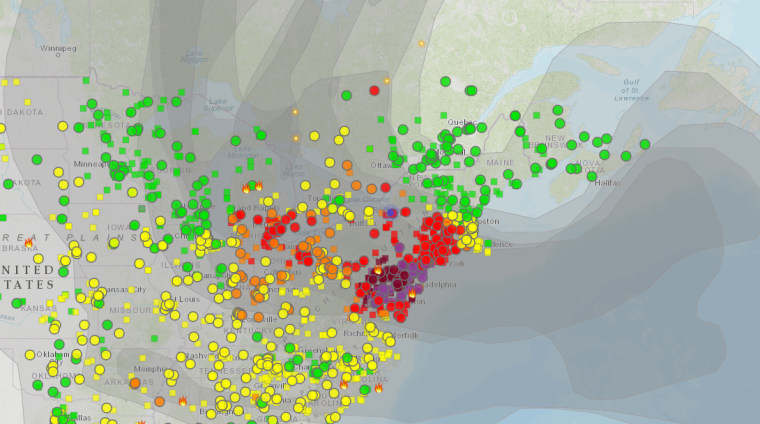
A map from AirNow.gov showed "unhealthy" air quality index across Michigan and Ohio, with parts of Pennsylvania, New York, New Jersey and Maryland reaching "very unhealthy" and "hazardous" levels around 8:30 a.m. ET.
AirNow is a government partnership that includes the U.S. Environmental Protection Agency, the National Oceanic and Atmospheric Administration, the National Park Service, NASA and the Centers for Disease Control and Prevention.
A man jogs through the Liberty State Park in Jersey City, New Jersey, while the smoke from the Canadian wildfires thickens the Manhattan skyline today.
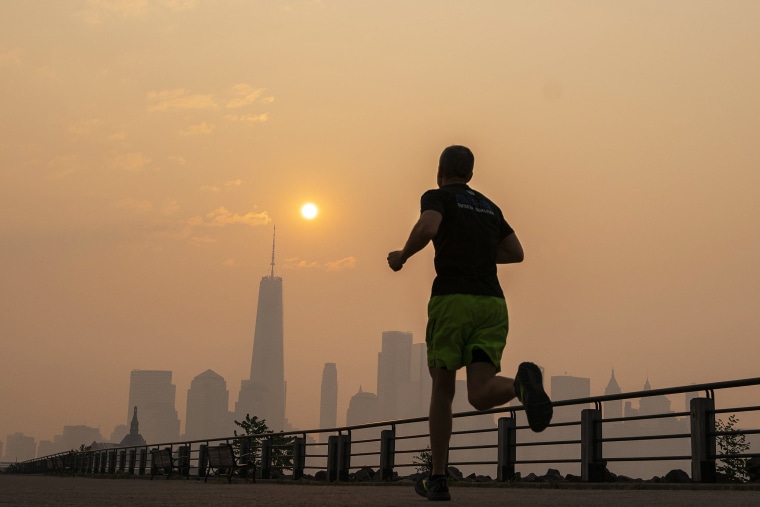
Is it safe to exercise outdoors when the air quality is poor?
The air quality in places like New York City, Philadelphia and other areas of the Northeast on Wednesday may give pause to outdoor exercise enthusiasts, including runners.
The air quality index, or AQI, in New York exceeded 340 Wednesday afternoon — making it the city with worst air quality in the world — as smoke from wildfires in eastern Canada wafted into the United States. The AQI runs from 0 to 500; higher numbers indicate greater levels of air pollution and greater health concerns, according to the Environmental Protection Agency.
Once levels exceed 150, running outdoors may become risky, said Dr. Panagis Galiatsatos, a pulmonologist with the American Lung Association.
NYC's LaGuardia Airport issues ground stop
A ground stop was in place at LaGuardia Airport in New York City early this morning due to low visibility from the wildfire smog over the Northeast.
By 7:40 a.m. ET, it was upgraded to a ground delay through 10 p.m., with departures delayed an average 54 minutes.
The Federal Aviation Administration said it had paused flights from the Northeast, Ohio and the mid-Atlantic bound for the airport.
Swiss air quality tracker's website appears to be down
Update: IQAir.com was back online as of 8:01 a.m. ET.
IQAir.com, a Swiss air quality monitoring service that suddenly became indispensable for shrouded people on the East Coast this week, appeared to be down this morning.
NBC News reporters who attempted to load the website received an error message, and a platform that checks the status of servers showed that IQAir was "unavailable."
IQAir.com was most likely overwhelmed by traffic.
Air quality health advisory remains in effect for NYC
An air quality health advisory will remain in effect in New York City until late tonight, Mayor Eric Adams said.
He said officials were expecting air quality to "continue to deteriorate" throughout the day as he called on residents to "mask up — especially our older New Yorkers and young children, and anyone with breathing or heart issues."
"Limit your outdoor activities to the absolute necessities," Adams warned.
People play basketball at Brooklyn Bridge Park as the lower Manhattan skyline is obscured by hazy skies yesterday.
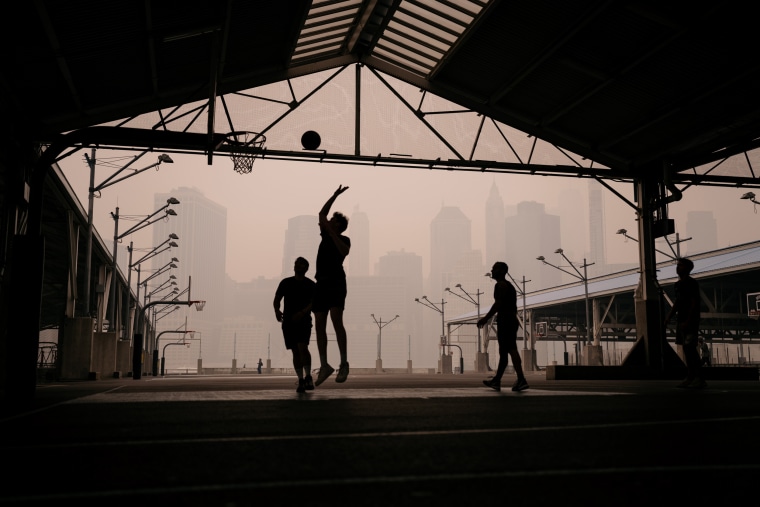
Chris Stapleton cancels outdoor concert in New York
Singer-songwriter Chris Stapleton canceled his outdoor concert in Syracuse yesterday, joining a series of Broadway performances and sports games in calling off events across New York state due to air quality conditions.
Stapleton tweeted about the cancellation, promising an update by today about a rescheduled show.
Lesson from Australian bush fires: ‘Take it very seriously’
Exposure to smoke from Canada’s wildfires could have lasting health effects, an Australian expert said, pointing to devastating bush fires in his country in 2019 and 2020.
“Take it very seriously, it has the potential to kill people,” Steve Robson, president of the Australian Medical Association, told NBC News.
He said there was “no doubt” that the smoke inhaled during those fires continues to affect the health of Australians, especially children and older people.
“I’m very, very concerned looking at what I see in the images from New York, Washington, the northeast of the U.S. that they’re going to have very similar health problems to those of Australia,” Robson said.
People with chronic conditions like asthma should be sure to manage them, he said. He advised vulnerable groups, including early care for people with respiratory or heart problems, pregnant women, newborns and older people.
“If it’s possible, find places where they have air purifiers or protection from the smoke, but I recognize that’s very, very difficult,” Robson said.
Biden has pledged additional firefighting support to Canada
President Joe Biden offered additional firefighting support to Canada to help suppress the blazes burning across the country.
He directed all available federal firefighting assets to assist with the effort, according to a readout of his call with Canadian Prime Minister Justin Trudeau yesterday.
The U.S. has deployed more than 600 firefighters and support personnel, as well as other resources, to assist with the fires, according to the readout.
A plane is framed by the sun as smoke from wildfires in Canada cause hazy conditions in Washington, D.C., yesterday.
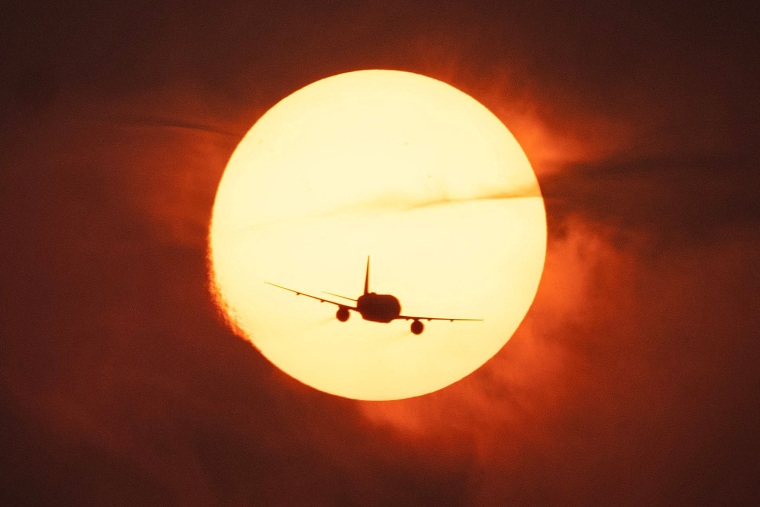
'Hamilton' and 'Camelot' cancel Broadway shows over air quality
"The show must go on," is usually the motto — but such was the poor air quality in New York City, a Broadway performance of "Hamilton" had to be called off last night.
"The hazardous air quality in New York City has made it impossible for a number of our artists to perform this evening," the official page for Hamilton announced. It said shows were expected to resume today and that refunds or exchanges would be made available.
"Camelot" also announced last evening's performance had been canceled, but did not say why. Spokeswoman Juliana Hannett told The New York Times it was due to air quality concerns.
What causes poor air quality?
Poor air quality can be caused by any airborne “irritant” — a particle or substance in the air that is harmful to a person to breathe in, according to Dr. Purvi Parikh, an allergist and immunologist at the Allergy & Asthma Network, an advocacy group for people with asthma, allergies and related conditions.
Some examples are air pollution, including from vehicles and carbon emissions, as well as rising ozone levels, she said. Natural disasters, like wildfires, often cause short-term spikes in poor air quality as the smoke, which contains carbon monoxide and other dangerous chemicals, enters the atmosphere.
Especially concerning is small particulate matter — tiny particles in the air that measure less than 2.5 micrometers in diameter, or roughly 4% of the width of a strand of hair. These particles are small enough to be inhaled deep into the lungs and can enter the bloodstream.
The Environmental Protection Agency uses the air quality index to report air quality. It ranges from 0 to more than 300, with levels 50 and below considered the healthiest. When levels exceed 150, the general population may start to experience symptoms. Over 200 is considered “very unhealthy.”
'Stay indoors' the prevailing message during hazardous haze
"Stay indoors" has been the prevailing message for New Yorkers and others affected by the hazardous haze impacting parts of the eastern U.S.
The National Weather Service in New York has been sharing guidance on how to protect yourself from wildfire smoke:
An orange moon rose over New York City overnight after wildfire smoke from Canada filled the air with haze. CNBC producer Brad Howard captured this photo on a very early morning walk with his dog.
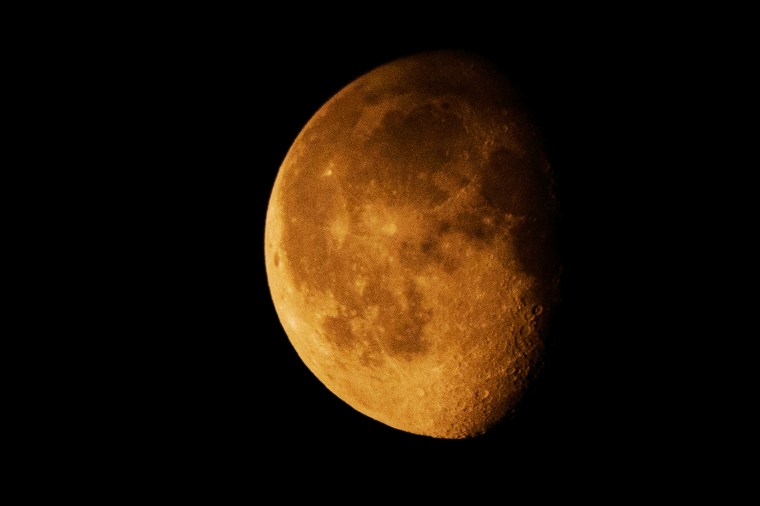
1 million N95 masks to be distributed across New York: Hochul
As many as 1 million N95 masks are expected to be made available at state facilities across New York this morning to help residents protect against smoke from Canadian wildfires, Gov. Kathy Hochul has said.
The governor warned New Yorkers that the "best way to stay safe right now is to stay indoors," however.
"We highly recommend outdoor activities be postponed or cancelled as we wait for safer air quality conditions," she said in a separate tweet. "If you must be outside for significant periods, wear a high-quality mask to reduce exposure."
Unhealthy air quality persists in major metro areas
Smoke from the wildfires in Canada continued to push southward into the eastern U.S. today, with sustained northerly winds propelling the haze.
Major metro areas, including New York City, Boston, Philadelphia and Washington, D.C. are expected to experience "unhealthy air quality levels for all age groups" through the day, the National Weather Service warned.
New Yorkers have a new reason to don masks, with many following guidance to wear face coverings to protect against the poor air quality.
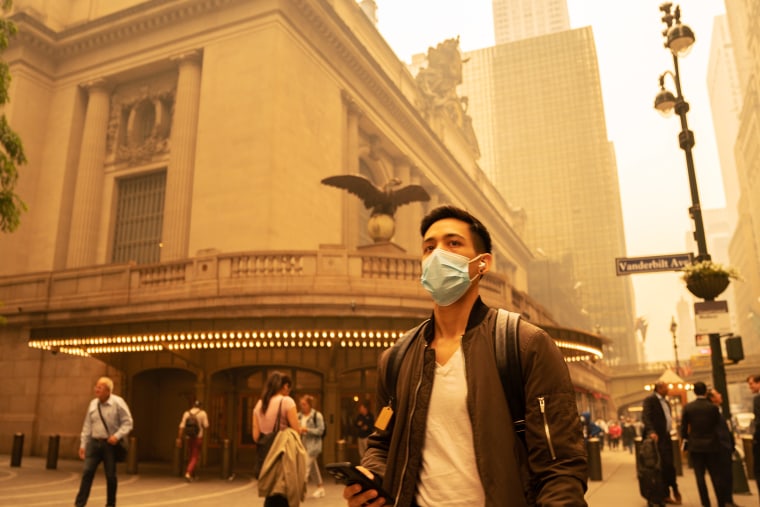
New York City continues to have the world's worst air quality
New York City continued to top the charts for worst air quality in the world early this morning, as smoke from Canadian wildfires continued to billow over much of the eastern U.S.
The Big Apple — or the Big Orange based on the hue of the haze that has gripped the city in recent days — had the worst air quality of any city across the globe this morning, with Detroit in third place, according to the tracking service IQAir.com.
In its global ranking, the tracking service listed New York City as having "unhealthy" air quality levels after it reached "very unhealthy" levels yesterday. Detroit similarly had unhealthy levels, but with a lower ranking than New York City.











